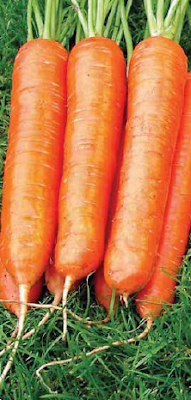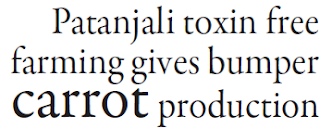 Government always exaggerate and manipulate agriculture production data but the fact is that farming is becoming weaker day-by-day. Farmers are migrating after quitting agriculture in search of some optional occupation. The recent research data expose the truth. Worried of the facts, Patanjali Toxin Free Agriculture Department is, making constant efforts to realize the dreams of Pujya Swamiji Maharaj to transform the situation of once, the agriculture based country. In the sequence, the agriculture scientists are not only doing high-level refined research but also making the results available to the common man. In the series, here is an article of carrot, the prime crop of `Rabi` season.
Government always exaggerate and manipulate agriculture production data but the fact is that farming is becoming weaker day-by-day. Farmers are migrating after quitting agriculture in search of some optional occupation. The recent research data expose the truth. Worried of the facts, Patanjali Toxin Free Agriculture Department is, making constant efforts to realize the dreams of Pujya Swamiji Maharaj to transform the situation of once, the agriculture based country. In the sequence, the agriculture scientists are not only doing high-level refined research but also making the results available to the common man. In the series, here is an article of carrot, the prime crop of `Rabi` season.
In every household in winter season, carrot is being used. It is though produced in entire country but it is the main crop of North India. Carrot is used in various manners like salad, vegetable, `halwa`, jelly etc. Iron is present in excessive amount in carrot and according to `Ayurveda Darshan`, it is beauty enhancer. `Kanji`, a product of black carrot is much digestible.
Carrot is a crop of cold climate. If the temperature is high, the roots become short and thick while if the temperature is low, carrot size is long, thin and attractive. The best temperature range for carrot production is 8 degree Celsius to 18 degree Celsius.
Preparation of land:
For the carrot crop production, loamy soil with proper drainage system is considered as the best. For
better production, 6.5 PH land is considered as the best. While preparing the farm, dressing should
be done with 2000 liter Sanjeevak fertilizer, prepared with the help of Patanjali process and tillage the land 3-4 times, with the help of plough. Shape the farm in equal area and sow the seeds in the bed or seed plot. Th e distance between seeds should be 10 cms while between two queues should be 30 cms. While sowing, take care that seed should not be buried lower than the depth of 1.5 cms or else the germination percentage drops. For every acre of land, 3.5 kg carrot seed is adequate.
Major Species:
Pusa Kesar – It is deep red conical shaped product. Its center part is small with deep red color. The plant has fewer branches but roots have more keratin proportion. The crop gets ready in 90 days and per acre production is around 80-90 quintals.
Pusa Medhali – The roots are orange colored, attractive in look.The sowing is normally done inmonsoon season. Its production is 100 quintals per acre.This specie develops in 120 days.
Chaitani – This specie is of dark red color and thick in size. It is the best specie for preparing vegetable and `halwa`. This is readied in 110 days.The production is 80 quintals per acre.
Irrigation and fertilizer :

The first irrigation in the carrot crop should be done soon aft er the sowing. While irrigation, use 1000 liter Patanjali fertilizer, prepared by Patanjali process essentially while second irrigation should be done one week aft er sowing. Since, the germination of the seed takes time, the moisture in the field should be maintained so that the germination percentage increases. After the germination of the seed, irrigate after gap of 15 days. When the crop is 60-65 days old, mix 50 kg granular fertilizer prepared by Patanjali Bio Research Institute mixed with 5 KG Patanjali Panchyog and sprinkle on the crops, which ensures better development of the roots.
Patanjali toxin free agriculture department has, in its practical research experiments use vermi compost fertilizer in the carrot crop and got bumper production. If farmer brothers use 150 kg of vermi compost per acre for initial 90 days at an interval of 15-15 days, the dimension and length of the carrot will have surprising development.
De-weeding:

Weeding is the most serious problem, observed in carrot crop. The weeds extract moisture and nutritious elements from the soil and hence hinder the development of the crop. Thus, from the crop, de-weeding is necessary at a definite interval. When the roots of carrot develop, make the soil airy so that the color change in the upper region of the roots does not take place. If de-weeding is done at a definite interval, better quality and production is ensured.
The natural treatments of the carrot crop diseases
1. `Adralingan` disease:
This disease mostly affects crops. This disease is caused due to phytium amphinidematum fungus. The disease infects the crop, as soon as seeds germinate. The lower portion of the stem, which is close to the soil gets rot and ultimately destroys the whole plant.
Treatment:
To keep the crop safe from the disease, seed treatment is the best process. To treat 3.5 kg of seed, add 2 liters of cow urine, 100 grams lime and 300 grams of cow dung or neem wood ash and keep the mixture for a night. Later, mix 4 liters of water and keep the seed in the mix for 10-12 minutes. Dry them in shadow and later sow.
2- Bacteria `Mridu Sadan`
Disease :
In the carrot crop, this disease is being spread by a special bacterium. It impacts on the pulp of the root. The roots get rot, reducing the productivity considerably.
Treatment
To save the crop from the disease, soon after irrigating the crop, sprinkle mix of ash and
copper sulfate. For every acre of crop, sprinkle 4 kg of ash in 1 kg of copper sulfate so that the crop remains safe from the disease.

Digging and production –
The digging should be done after watching the upper portion of the carrot, i.e. its thickness (diameter).When the diameter is 2-3 cms, irrigate the farm and carefully take out the carrot roots.
Following the above methods, production of 100-110 quintal per acre could be received.





















0 comments:
Post a Comment
Note: Only a member of this blog may post a comment.